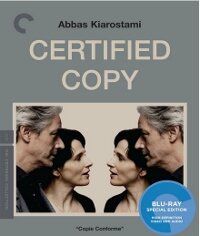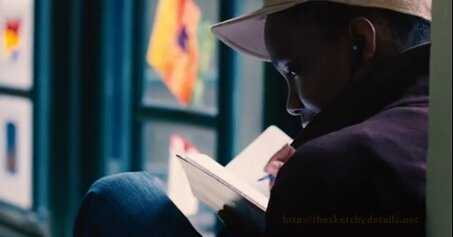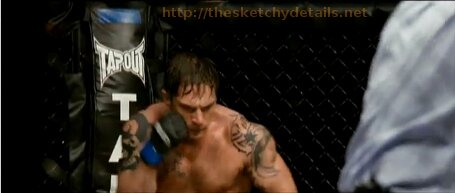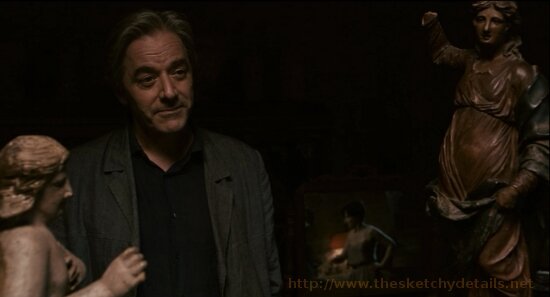In this edition of Instant Watch, we’re going to take a look a three films all about alternatives to traditional education available to stream at Netflix. Even when a traditional classroom is in the picture, the behavior of the students and staff alike push it beyond the boundaries of your standard public school experience. It is by coincidence alone that all three films were nominated for Academy Awards. Maybe the Oscars are big on films that comment on education.
Half Nelson (2006)
Something is going on with 8th grade history teacher Dan Dunne. He refuses to follow the set curriculum out of boredom, pushing students to examine the entire history of the world through dialectics. Mr. Dunne is addicted to cocaine. His student Drey finds him in the girl’s locker room, high. They begin to form a friendship over the shared secret, forcing them both to confront their understanding of their lives, the education system, and how friendship really works.

Dan Dunne wanders into school late for the first time.
Half Nelson is a very relaxed film. There are no emotional highs, no sustained fights, and only one scene where anyone’s voice rises above proper classroom behavior. The great strength of the film is how underplayed the dramatic arcs are.
Ryan Gosling is Dan Dunne. There is not a moment in the film where he steps out of the downward spiral of a man who believes he finally has his life under control. Everything, from the disinterested saunter into the school building to his over inflated sense of self, rings true. The fate of Half Nelson relies on this performance and Ryan Gosling makes everything feel real and effortless. It’s enough to make you worry that your local teachers might get away with this behavior.
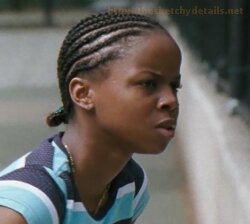
Drey watches out for her teacher in Half Nelson
Perhaps the most cliched element of
Half Nelson is the mandatory bond between teacher and student in an education drama. However, Drey is not your typical student relying on a teacher for guidance. Shareeka Epps gives a strong and nuanced performance as Mr. Dunne’s student who uncovers his drug addiction. It would be so easy for Drey to become this magical child who completely changes everyone’s life who encounters her. With Epps’ performance, she’s not. She’s not perfect. She’s not a bright spot in a troubled world. She’s simply a child getting by with a mother who can’t afford to spend more time at home.
Half Nelson refuses to meet your expectations. This is not the typical public school drama. There are no troubled youth needing redemption. There is no major test or challenge the students have to overcome. In fact, the classroom scenes are only used as a framing device to gauge the changes in Dan Dunne. There’s subtext about the Civil Rights movement, but it’s never drawn to the forefront. The white teacher becomes friends with his black student and worries about her safety.
Writers/directors Ryan Fleck and Anna Boden do a remarkable job staying away from what you expect in a teaching drama. This is a character study of a man who refuses to open up beyond a glint in his eyes. It’s a coming of age story where the young girl is already more adjusted to reality than the adults teaching her. It’s a study in drug abuse that chooses to show how well people can get by in society while high.
Half Nelson is a film that slowly washes over you. Dan Dunne draws you in with his confidence, then leaves you to piece together the rest yourself. For people willing to actively engage with a film that has no easy answers, Half Nelson is a rewarding viewing.
Rating: 8/10
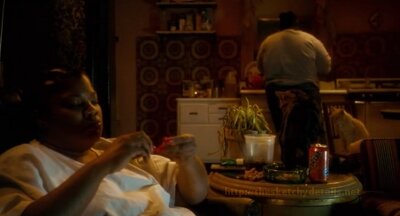
Precious faces dueling educational forces in her life.
Precious: Based on the Novel ‘Push’ by Sapphire (2009)
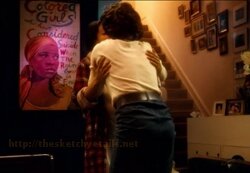
Director Lee Daniels pushes Precious to be an inspirational but realistic look into a young woman's psychological development.
Precious is one of those films I’ve been obsessed with since it came out. Part fantasy, part drama, part deeply psychological character study, director Lee Daniels’ powerful feature about a sexually and psychologically abused 16 year old teenager takes a challenging novel and turns it into a piece of cinematic magic. It must have been hard to imagine how a story so driven by internal monologues and terrible abuse could translate to the screen. Lee Daniels takes Geoffrey Fletcher’s Academy Award winning adaptation of Sapphire’s novel
Push and turns it into the kind of film that makes you appreciate the magic of filmmaking.
Perhaps the saddest part of Precious‘ legacy is the cultural narrative of the film. Despite incredible direction, writing, performances, design, and editing, Precious could have been subtitled “The Mo’Nique Show.” It is true that Mo’Nique gives an outstanding performance as Precious’ abusive mother Mary. She is not a caricature of an abusive parent or a cartoonish villain. Mary is terrifying because she is all too real. There are clear mental health problems happening that Mary has no interest in addressing. So long as she gets her welfare check on the basis of living with Precious and lying about caring for her granddaughter, she’s fine with whatever happens in her life.
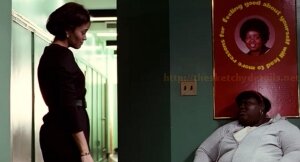
Precious is greeted by her new teacher at the alternative school.
The reason the focus on Mary and Mo’Nique’s performance is so unnerving is the caliber of acting in the film. If Mary didn’t exist as a character, any number of the other women in the film would have stolen all the focus in the supporting cast. Paula Patton actually behaves like the teachers I work with. She takes the role of a teacher at an alternative school for troubled young women and wrings out every possible special moment. Mariah Carey goes toe to toe with Mo’Nique and Gabourey Sidibe as their welfare agent and manages to steal focus while confined to a rolling chair in a gray cubicle. Even smaller players like Sherri Shepherd as the school’s secretary and Xosha Roquemore as a wacky classmate bring much needed warmth and humanity to the film.
Gabourey Sidibe plays Precious to perfection. It’s so hard to describe what she does in this film. She’s the narrator discussing her life experience in voice over. She’s the superhero of her own fantasies, the villain in her own reality, the epitome of self doubt to her new teacher, and the worst mistake in the history of the world to her mother. She is a child forced to grow up too fast, a woman incapable of understanding her life beyond her relationship to her mother and father, and a person trapped in a pattern of escapism. Sidibe needs more screenplays that showcase what she can do. It is a sin to waste this much talent on bit parts in ensemble comedies.
The problem with Precious is one of branding. This became the film known for the abusive mother and the troubled child rather than the far more positive direction and arc of the film. Precious is a victim who forces herself to improve her life. She goes to school, she makes friends, and she slowly comes to terms with her worth as a person. She dreams big–could she be a movie star? a rockstar? a model? happy? fulfilled? confident?–and finds a way to overcome the obstacles in her life.
Precious is not a depressing film. It is joyful. It is heartfelt. It is beautiful and inspiring and realistic even in its use of fantasy to explore the human psyche. Does the tone make the terrible abuse easier to watch? Barely. The film is balanced between the dark and the light in a way that naturally brings out the best and worst in every moment. It is a lifetime of experiences distilled down to one year of a young woman’s life. If you have about two hours and feel up to it, Precious will not let you down.
Rating: 10/10

The siblings of Dogtooth celebrate their teachers/parents' wedding anniversary.
Dogtooth (2009)

The siblings of Dogtooth are adults trapped as young children by their parents.
Dogtooth is a strange film by design. Writer/director Giorgos Lanthimos and co-writer Efthymis Filippou craft a story of educational abuse unlike any other. Father and Mother teach their three adult children–Son, Older Daughter, and Younger Daughter–false definitions of words and bizarre lies about the outside world to confine them to their large remote home for life. Their only chance for escape is the loss of their dogtooth (right or left, doesn’t matter), which means they are old enough to walk through the gate and not be killed instantly.
Dogtooth doesn’t really have a story. It’s a meandering look into a bizarre and abusive family. The children haven’t developed psychological reasoning beyond small children because their parents wouldn’t let them. They compete in dangerous games and tasks to earn stickers on their bed frames. They’re savagely punished if they step out of line and rewarded with more indoctrination if they do well.

The siblings in Dogtooth invent strange games to occupy their time.
Its so hard to understand what, exactly, is happening in
Dogtooth. It’s not a character study as the characters don’t evolve or show depth beyond their initial introduction. If it’s meant to be a comedy, it is very dark and bloody. The gags are dry and the abuse going on is hard to swallow.
What I fear is that Dogtooth might be losing a lot in translation. It’s a Greek film with a lot of flatly delivered dialogue. My suspicion is that, with the readily available subtitles, we’re losing out on clever wordplay and idioms that don’t translate well. Perhaps it’s a fitting satire of a Greek cultural or political institution. I just don’t have the frame of reference to judge it in that context.
The reason I’m so torn on Dogtooth is that I enjoyed watching it in spite of how little sense it made. It felt very much like Lars von Trier’s The Idiots, only without an accessible lesson or theme to grab onto. The family does strange things just to do strange things and the technical filmmaking makes them interesting. The film has a fantastic eye for color and framing that makes it a perverted piece of moving art.
It’s hard to recommend Dogtooth beyond a twisted sense of curiosity. I remember a lot of writers were very confused that this received a nomination for Best Foreign Language Film at the Academy Awards. It’s just so strange that it’s hard to imagine its audience. It’s not campy enough for the cult fans, dark enough for the horror fans, or absurd enough for post modern comedy fans or Modernists. It is a self-contained exploration of a twisted educational fantasy and doesn’t strive to be anything more.
Rating: 5/10
Thoughts on these films? Suggestions of other alternate schooling films on Netflix? Sound off below.
